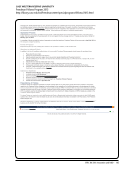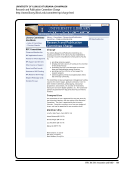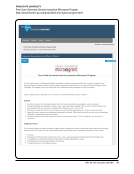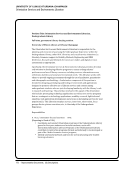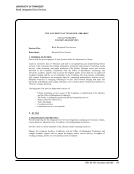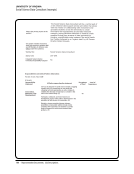SPEC Kit 339: Innovation and R&D · 15
skills recommended by survey respondents include
assessment an ability to collaborate and to manage
collaborations, including the work product, as well as
the interactions facilities and space planning political
savvy and specific functional and technological skills,
such as data curation and management, collection de-
velopment, and working with large media files.
Survey participants felt that library profession-
als could gain these skills using a number of means.
Everyone indicated that on-the-job experience was
one way in which librarians could gain the necessary
skills, followed by self-study (37 or 84% of respon-
dents). Other ways librarians could gain the requisite
skills, although not to the same degree as on-the-
job experience or self-study, include participating
in externally offered workshops (22 or 50%), online
workshops or courses (17 or 39%), and workshops or
courses offered by the library (11 or 25%). Other sug-
gestions for bringing the needed skills into the orga-
nization include hiring staff who bring the necessary
qualifications, librarians providing mentoring to their
colleagues, and consultation with on-campus experts.
Respondents identified numerous professional
meeting or conference opportunities that they be-
lieve inspire innovative thought and activities. Many
of these tend to be technology or technology, ser-
vice, and policy meetings, such as CNI, the Joint
Conference on Digital Libraries, EDUCAUSE, the
Digital Library Federation Forum, and the Library
and Information Technology Association conference.
Others are focused on mainstream library profes-
sional conferences, such as ALA, ACRL, and SAA.
ARL workshops were mentioned, as were discipline-
specific professional meetings, such as the Modern
Language Association meeting.
Libraries responding to the survey indicated that
they recognize and reward innovative activities in a
number of ways, including the merit/performance
review process (36 or 82%) press releases to local,
institutional, and national audiences (27 or 61%) and
through an award or some type of recognition citation
(19 or 43%). Respondents suggested that their librar-
ies also use a number of other forms of recognition
for innovation, including nomination for a variety
of awards, some specifically referencing innovation
at the library, institution or state/national levels
recognition in the library internal newsletter and
increased opportunities for professional development.
Library Innovation: Assessment
The survey explored the ways in which libraries are
assessing the outcomes of innovation, specifically ask-
ing about the case study example. Assessment is clear-
ly a priority for most of the libraries that responded to
the survey. While the motivations for assessment may
vary, there is a clear value to assessing and sharing the
outcomes of innovative activities. Many of these activi-
ties were funded with library operating funds, as well
as competitive internal and external funding or donor
support, and are likely to be highly visible activities.
Assessment provides the objective lens through which
to view the merit of any activity, and to determine
whether it serves the purpose for which it was in-
tended, or perhaps some other unintended purpose.
Seventeen of the 44 responding libraries (39%) have
already assessed or evaluated the innovative activity
in the case study example, and half plan to evaluate
the outcome of their activity. Only a small number of
the libraries that responded (5 or 11%) indicated that
they had no plans to evaluate their innovative activity.
Libraries who did evaluate the innovative activ-
ity reported using a variety of methods to assess the
outcomes of the case study examples. The top three
assessment approaches used include the collection
and analysis of data on use of innovative services or
products (26 or 67%), user surveys (20 or 51%), and
interviews with individuals who use innovative ser-
vices or products (20 or 51%). Other methods used
include report submission, focus group interviews,
pre- and post-tests, citation analysis, and ongoing
analysis of customer feedback.
The survey also asked how libraries would char-
acterize the extent of change due to their specific case
study innovative activity. Eight of the 44 libraries that
responded to this question (18%) thought the change
was incremental, nine (21%) judged the change in their
library to be radical, and 27 (61%) felt that the change
was “somewhere in between.”
Research &Development
In order to better understand whether and to what ex-
tent libraries have identified research and development
skills recommended by survey respondents include
assessment an ability to collaborate and to manage
collaborations, including the work product, as well as
the interactions facilities and space planning political
savvy and specific functional and technological skills,
such as data curation and management, collection de-
velopment, and working with large media files.
Survey participants felt that library profession-
als could gain these skills using a number of means.
Everyone indicated that on-the-job experience was
one way in which librarians could gain the necessary
skills, followed by self-study (37 or 84% of respon-
dents). Other ways librarians could gain the requisite
skills, although not to the same degree as on-the-
job experience or self-study, include participating
in externally offered workshops (22 or 50%), online
workshops or courses (17 or 39%), and workshops or
courses offered by the library (11 or 25%). Other sug-
gestions for bringing the needed skills into the orga-
nization include hiring staff who bring the necessary
qualifications, librarians providing mentoring to their
colleagues, and consultation with on-campus experts.
Respondents identified numerous professional
meeting or conference opportunities that they be-
lieve inspire innovative thought and activities. Many
of these tend to be technology or technology, ser-
vice, and policy meetings, such as CNI, the Joint
Conference on Digital Libraries, EDUCAUSE, the
Digital Library Federation Forum, and the Library
and Information Technology Association conference.
Others are focused on mainstream library profes-
sional conferences, such as ALA, ACRL, and SAA.
ARL workshops were mentioned, as were discipline-
specific professional meetings, such as the Modern
Language Association meeting.
Libraries responding to the survey indicated that
they recognize and reward innovative activities in a
number of ways, including the merit/performance
review process (36 or 82%) press releases to local,
institutional, and national audiences (27 or 61%) and
through an award or some type of recognition citation
(19 or 43%). Respondents suggested that their librar-
ies also use a number of other forms of recognition
for innovation, including nomination for a variety
of awards, some specifically referencing innovation
at the library, institution or state/national levels
recognition in the library internal newsletter and
increased opportunities for professional development.
Library Innovation: Assessment
The survey explored the ways in which libraries are
assessing the outcomes of innovation, specifically ask-
ing about the case study example. Assessment is clear-
ly a priority for most of the libraries that responded to
the survey. While the motivations for assessment may
vary, there is a clear value to assessing and sharing the
outcomes of innovative activities. Many of these activi-
ties were funded with library operating funds, as well
as competitive internal and external funding or donor
support, and are likely to be highly visible activities.
Assessment provides the objective lens through which
to view the merit of any activity, and to determine
whether it serves the purpose for which it was in-
tended, or perhaps some other unintended purpose.
Seventeen of the 44 responding libraries (39%) have
already assessed or evaluated the innovative activity
in the case study example, and half plan to evaluate
the outcome of their activity. Only a small number of
the libraries that responded (5 or 11%) indicated that
they had no plans to evaluate their innovative activity.
Libraries who did evaluate the innovative activ-
ity reported using a variety of methods to assess the
outcomes of the case study examples. The top three
assessment approaches used include the collection
and analysis of data on use of innovative services or
products (26 or 67%), user surveys (20 or 51%), and
interviews with individuals who use innovative ser-
vices or products (20 or 51%). Other methods used
include report submission, focus group interviews,
pre- and post-tests, citation analysis, and ongoing
analysis of customer feedback.
The survey also asked how libraries would char-
acterize the extent of change due to their specific case
study innovative activity. Eight of the 44 libraries that
responded to this question (18%) thought the change
was incremental, nine (21%) judged the change in their
library to be radical, and 27 (61%) felt that the change
was “somewhere in between.”
Research &Development
In order to better understand whether and to what ex-
tent libraries have identified research and development

















































































































































